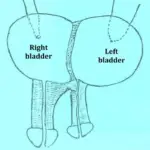Epispadias is a birth defect with a consequential urethral opening at the dorsal surface of the penis.
What is the Pathology of Epispadias?
The pathology of epispadias is:
-Etiology: The cause of epispadias is unknown.
-Genes involved: Unknown.
-Pathogenesis: The sequence of events that lead to epispadias still is unknown.
-Morphology: The morphology associated with epispadias shows glandular, penile, and penopubic forms depending on the position of the meatus.
How does Epispadias Present?
Patients with epispadias are typically young males. The symptoms, features, and clinical findings associated with epispadias include urinary incontinence, and abnormal position of urethral opening on examination.
How is Epispadias Diagnosed?
Epispadias is diagnosed through physical examination.
How is Epispadias Treated?
Epispadias is treated by surgical intervention.
What is the Prognosis of Epispadias?
The prognosis of epispadias is good with surgical intervention, although nocturnal incontinence may persist.



